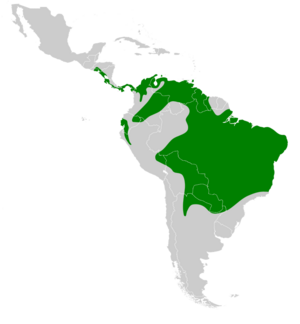Pearl kite facts for kids
The pearl kite (Gampsonyx swainsonii) is a tiny raptor. It lives in open grasslands called savannas, often near forests. This bird is the only one in its group, called Gampsonyx. Its scientific name honors William Swainson, an English naturalist.
Quick facts for kids Pearl kite |
|
|---|---|
 |
|
| Pearl Kite in savannah | |
| Conservation status | |
| Scientific classification | |
| Genus: |
Gampsonyx
|
| Species: |
swainsonii
|
| Subspecies | |
|
|
 |
|
Contents
What is the Pearl Kite?
The pearl kite was first described in 1825 by Nicholas Aylward Vigors. He noticed it looked a bit like both hawks and falcons. However, he placed it with hawks because it didn't have the special notched beak that falcons do. He also thought it looked a lot like small falcons called falconets because of its colors.
For a while, people thought the pearl kite was related to falcons. But later, scientists studied its body and how it sheds feathers. They found it was actually more closely related to Elanus kites, like the white-tailed kite.
Where Does the Pearl Kite Live?
This small kite lives in many parts of Central and South America. You can find it from Panama, Colombia, and Venezuela all the way south to Bolivia and northern Argentina. There's also a group that stays in Nicaragua.
The pearl kite is spreading its home range. It was first found breeding on the island of Trinidad in 1970. It also started appearing in Costa Rica in the mid-1990s. Now, it's quite common there, especially along the Pacific coast, up to 1000 meters high.
What Does the Pearl Kite Look Like?
The pearl kite is about 20 to 23 centimeters (8 to 9 inches) long. It weighs around 80 to 95 grams (2.8 to 3.4 ounces). It is the smallest raptor in North and South America. It's also one of the two smallest accipitrids (a family of birds of prey) in the world. Only the little sparrowhawk is similar in size.
Adult pearl kites have a black top of the head, back, wings, and tail. They have a white collar with reddish-brown edges. Their forehead and cheeks are yellow. Their belly is mostly white, and their legs are yellow.
Young pearl kites look similar to adults. However, they have white and chestnut tips on their back and wing feathers. Their collar is a buff color, and they have some buff (light yellowish-brown) on their white belly. When flying, this bird looks mostly black from above and white from below. The pearl kites from the northern areas (G. s. leonae) have reddish-brown sides, which is different from the main group (G. s. swainsonii).
Life Cycle and Reproduction
Pearl kites build a deep, cup-shaped nest using sticks. They usually place their nest high up in a tree. A female pearl kite lays 2 to 4 white eggs with brown marks. She does most of the incubating, which means sitting on the eggs to keep them warm.
The eggs hatch after about 34 to 35 days. After hatching, the young birds stay in the nest for another five weeks until they are ready to fly. Sometimes, a pair of pearl kites might raise two groups of babies in one season.
What Does the Pearl Kite Eat?
The pearl kite mainly eats lizards. Some of its favorite lizard meals include Anolis lizards and geckos. Its most common prey is a lizard called Microlophus occipitalis.
Besides lizards, pearl kites also catch small birds, like ruddy ground doves. They also eat frogs and insects, such as cockroaches. A pearl kite usually sits on a high, open branch. From there, it quickly swoops down to catch its prey. The call of the pearl kite sounds like a high, musical pip-pip-pip-pip or kitty-kitty-kitty.



